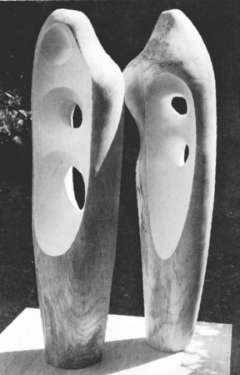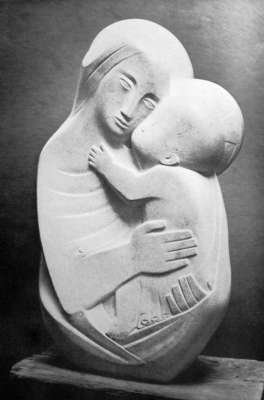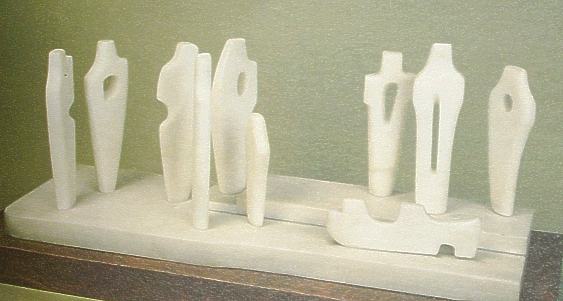
Two Figures 1948 BH147
Changing Influences
After the intoxicating tension of her initial Cornish Sculptures, her work deviates and becomes more dynamic and experimental. In 1951 she quotes:
"…for a few years I became the object. I was the figure in the landscape and every sculpture contained to a greater or lesser degree the ever changing forms and contours embodying my own response to a given position in that landscape. "

Two Figures 1948 BH147
During the preceding years she begin to experiment with Human form (in the landscape) - representing it in a very abstract ways. Sculptures such as Single Form (Dryad) 1945 BH132, Two Figures 1947 above, and Rhymic Form 1949 BH158, Contrapuntal Form 1951 BH165 are simple and refined, they express the presence of the form. These differ form Henry Moore's work as he gives roles and meanings to his more organic forms, where Hepworth merely cuts the presence for the negative space.
The post war period was a great time of change, socially, politically and culturally. Hepworth was very socially aware and ensured that she and her fellow artists kept on good relations with their adopted community. When in 1948 the government established the National Health Service, Barbara was very interested.

Detail From: Fenestration of the Ear (The Hammer) 1948
When invited by a family acquaintance, a surgeon, to observe operations in the new NHS Barbara immediately took up this offer, becoming intensely interested by this new social experiment. She made numerous sketches in the operating theatres, which she enlarged onto large prepared boards. These boards were prepared with layers of paint, which she sanded and scraped into to establish shape, and added intense blocks of colour to emphasise form. These drawings are said to have captured the optimism and enthusiasm of the era.

Biolith, 1948 BH155 -
Awarded the Hoffman Gold medal at the Venice Biennale
At the start of the 1950's Hepworth was beginning to win international recognition for her work. She was invited to represent British Sculpture at the Venice Biennale (Although her work was overshadowed by Moore's reputation at the show 2 years previously). Hepworth was getting the acclaim that she had always wanted.

Madonna and Child 1953 BH193-
Carved by Hepworth after the news of her son's Death
Travelling firstly to Italy, and then to Greece (in 1953) gave her a break from difficulties in her personal life - the break down of her marriage and then death of her son Paul Skeaping. I think this marks a point of change in her work.
Brimming with enthusiasm from her visits to both Italy and Greece she remarked in a 1956 BBC radio interview:
"Here in West Penwrith there is great similarity with the light and quality I appreciated when I was out in Greece and the Aegean one thing stuck me forcibly … that was the emphasis of the human figure in landscape or related to the sea"
From her experience visiting Venice, absorbing the atmosphere, observing the people moving through the cities' squares and public spaces, she formulated a series of figurative groups. Such as Concourse 1951 , People Waiting 1952 BH181 and Evocation 1952 below. These contain similar - yet more simple expressions of a human forms (than those of the 1940's), but with each of the forms working unison, to create an atmosphere. The spatial positioning creates subtle relationships between the figures. The silhouettes of the figures capture mood, and feeling of each form through accentuating body language using angular shapes.

Group III (Evocation), 1951 BH182
Photographs can go a little way in capturing the overall effect of the sculptural groups, but one really needs to see them in person. When I was at the centenary exhibition of BHat the Tate St Ives, a collection from the series had been brought together. As one walked around them the light, shadow and changing position made me feel that I was experiencing walking past a busy crowd of people.
Another product of her visits was the carvings in "sented guarea" - a Nigerian hardwood. Hepworth took delivery of some 17 tonnes of the wood and arranged the storing and shipping of the wood at quite some cost. She poured her enthusiasm for the Greek landscape into a series of sculptures Corinthos, 1954 BH198, Curved Form 1955 (Delphi) BH199, Configuration (Phira), 1955 BH200, Oval Sculpture (Delos), 1955 BH201 , Pierced Form (Epidauros) 1960 BH290 . These consist of very large chunks of the wood being shaped then tunnelled through. This tunnelling explored the inner form of the wood, opening it up making the space inside bigger than the outside. Plaster was applied to the inside of large wooden sculptures. The plaster gave the effect of painting a room white- it makes it look bigger, so by white washing the inner forms we get an illusion of more space within the form that out side it.

Hollow from Penwrith, 1955/6 BH202
I think the use of the inner and outer spaces of form, which give cave like qualities to the exploration of a feeling. reflecting the natural urge we feel to look deeper or explore further in to our landscape.